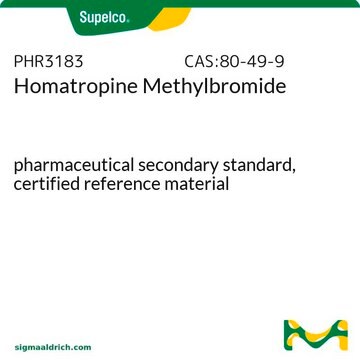H0800000
Homatropine hydrobromide
European Pharmacopoeia (EP) Reference Standard
Synonyme(s) :
DL-Homatropine hydrobromide, DL-endo-α-Hydroxybenzeneacetic acid 8-methyl-8-azabicyclo[3.2.1]oct-3-yl ester hydrobromide, Tropine mandelate hydrobromide
About This Item
Produits recommandés
Qualité
pharmaceutical primary standard
Famille d'API
homatropine
Fabricant/nom de marque
EDQM
Pf
214-217 °C (lit.)
Application(s)
pharmaceutical (small molecule)
Format
neat
Température de stockage
2-8°C
Chaîne SMILES
Br.CN1C2CCC1CC(C2)OC(=O)C(O)c3ccccc3
InChI
1S/C16H21NO3.BrH/c1-17-12-7-8-13(17)10-14(9-12)20-16(19)15(18)11-5-3-2-4-6-11;/h2-6,12-15,18H,7-10H2,1H3;1H
Clé InChI
DWSGTFTVBLXELC-UHFFFAOYSA-N
Vous recherchez des produits similaires ? Visite Guide de comparaison des produits
Description générale
Application
Conditionnement
Autres remarques
Produit(s) apparenté(s)
Code de la classe de stockage
11 - Combustible Solids
Classe de danger pour l'eau (WGK)
WGK 3
Point d'éclair (°F)
Not applicable
Point d'éclair (°C)
Not applicable
Choose from one of the most recent versions:
Certificats d'analyse (COA)
Sorry, we don't have COAs for this product available online at this time.
If you need assistance, please contact Service Clients
Déjà en possession de ce produit ?
Retrouvez la documentation relative aux produits que vous avez récemment achetés dans la Bibliothèque de documents.
Notre équipe de scientifiques dispose d'une expérience dans tous les secteurs de la recherche, notamment en sciences de la vie, science des matériaux, synthèse chimique, chromatographie, analyse et dans de nombreux autres domaines..
Contacter notre Service technique






